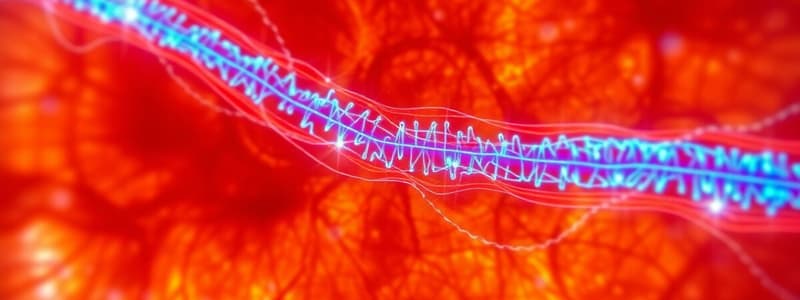Podcast
Questions and Answers
Which of the following best describes the role of opsin in visual pigments?
Which of the following best describes the role of opsin in visual pigments?
- It hydrolyzes cyclic GMP (cGMP) to close ion channels.
- It is a light-sensitive molecule derived from Vitamin A.
- It transports all-trans-retinol to the retinal pigment epithelium (RPE).
- It determines the specific wavelength of light the pigment absorbs. (correct)
The conversion of all-trans-retinal back to 11-cis-retinal is essential for the recovery of visual pigments after exposure to light.
The conversion of all-trans-retinal back to 11-cis-retinal is essential for the recovery of visual pigments after exposure to light.
True (A)
What is the primary function of transducin once it interacts with metarhodopsin II?
What is the primary function of transducin once it interacts with metarhodopsin II?
Transducin activates cGMP phosphodiesterase (PDE6).
In the context of vision, a decrease in __________ levels leads to the closure of cGMP-gated sodium and calcium channels.
In the context of vision, a decrease in __________ levels leads to the closure of cGMP-gated sodium and calcium channels.
Match the following enzymes with their primary action in visual signal transduction:
Match the following enzymes with their primary action in visual signal transduction:
Which of the following is NOT a typical outcome of excessive nitric oxide (NO) production in neurodegenerative diseases?
Which of the following is NOT a typical outcome of excessive nitric oxide (NO) production in neurodegenerative diseases?
Nitric oxide (NO) always has detrimental effects in the nervous system.
Nitric oxide (NO) always has detrimental effects in the nervous system.
What is the role of cellular retinaldehyde-binding protein (CRALBP) in the retinoid cycle?
What is the role of cellular retinaldehyde-binding protein (CRALBP) in the retinoid cycle?
In Alzheimer's disease, aggregates of __________ form plaques that disrupt synaptic function and trigger neuroinflammation.
In Alzheimer's disease, aggregates of __________ form plaques that disrupt synaptic function and trigger neuroinflammation.
Match the following neurodegenerative diseases with the protein primarily involved in their pathogenesis:
Match the following neurodegenerative diseases with the protein primarily involved in their pathogenesis:
Which structural change occurs when photons of light strike the retina?
Which structural change occurs when photons of light strike the retina?
Night blindness can be directly caused by a deficiency in Vitamin C.
Night blindness can be directly caused by a deficiency in Vitamin C.
What is the primary role of the enzyme nitric oxide synthase (NOS)?
What is the primary role of the enzyme nitric oxide synthase (NOS)?
__________ is a heterotrimeric G-protein that interacts with metarhodopsin II and initiates the intracellular signaling cascade in photoreceptor cells.
__________ is a heterotrimeric G-protein that interacts with metarhodopsin II and initiates the intracellular signaling cascade in photoreceptor cells.
Match the type of Nitric Oxide Synthase (NOS) with its location:
Match the type of Nitric Oxide Synthase (NOS) with its location:
Which of the following is a characteristic feature of Retinitis Pigmentosa?
Which of the following is a characteristic feature of Retinitis Pigmentosa?
Hyperpolarization of photoreceptor cells leads to an increased release of glutamate.
Hyperpolarization of photoreceptor cells leads to an increased release of glutamate.
Name one therapeutic strategy aimed at reducing the effects of protein aggregation in neurodegenerative diseases.
Name one therapeutic strategy aimed at reducing the effects of protein aggregation in neurodegenerative diseases.
In Parkinson’s Disease, misfolded __________ aggregates to form Lewy bodies.
In Parkinson’s Disease, misfolded __________ aggregates to form Lewy bodies.
Match the misfolded protein with its mechanism of action:
Match the misfolded protein with its mechanism of action:
Flashcards
Visual Pigments
Visual Pigments
Specialized proteins in photoreceptor cells (rods and cones) that absorb light and initiate vision.
Opsin
Opsin
A large protein in visual pigments that determines which specific wavelength of light the pigment absorbs.
Retinal (Chromophore)
Retinal (Chromophore)
A light-sensitive molecule derived from Vitamin A that is covalently bound to opsin.
Photoisomerization
Photoisomerization
Signup and view all the flashcards
Metarhodopsin II
Metarhodopsin II
Signup and view all the flashcards
Transducin
Transducin
Signup and view all the flashcards
cGMP Phosphodiesterase (PDE6)
cGMP Phosphodiesterase (PDE6)
Signup and view all the flashcards
Visual Pigment Regeneration
Visual Pigment Regeneration
Signup and view all the flashcards
Cellular Retinaldehyde-Binding Protein (CRALBP)
Cellular Retinaldehyde-Binding Protein (CRALBP)
Signup and view all the flashcards
Membrane Potential Recovery
Membrane Potential Recovery
Signup and view all the flashcards
Night Blindness
Night Blindness
Signup and view all the flashcards
Retinitis Pigmentosa
Retinitis Pigmentosa
Signup and view all the flashcards
Nitric Oxide Synthase (NOS)
Nitric Oxide Synthase (NOS)
Signup and view all the flashcards
Peroxynitrite
Peroxynitrite
Signup and view all the flashcards
Oxidative Stress (NO)
Oxidative Stress (NO)
Signup and view all the flashcards
Alzheimer's Disease (NO)
Alzheimer's Disease (NO)
Signup and view all the flashcards
Amyloid-β (Aβ)
Amyloid-β (Aβ)
Signup and view all the flashcards
Tau Protein
Tau Protein
Signup and view all the flashcards
α-Synuclein
α-Synuclein
Signup and view all the flashcards
Study Notes
- Visual pigments are specialized proteins in retinal photoreceptor cells (rods and cones).
- Absorb light to initiate vision.
Visual Pigment Composition
- Opsin is a large protein that determines the specific light wavelength absorption.
- Rod cells contain rhodopsin.
- Cone cells have three photopsins for blue, green, and red light sensitivity.
- Retinal (chromophore) is a light-sensitive molecule from Vitamin A (11-cis-retinal), covalently bound to opsin.
Structural Changes in Light Reception
- Photons striking the retina cause photoisomerization.
- 11-cis-retinal converts to all-trans-retinal.
- This transforms rhodopsin into its active form, metarhodopsin II.
- Metarhodopsin II activates the heterotrimeric G-protein transducin.
- Activated transducin stimulates cGMP phosphodiesterase (PDE6).
- PDE6 hydrolyzes cyclic GMP (cGMP).
- Reduced cGMP closes cGMP-gated sodium (Na+) and calcium (Ca2+) channels.
- This results in hyperpolarization of the photoreceptor cell membrane.
Intracellular Signal Transmission
- Hyperpolarization reduces the release of the neurotransmitter glutamate.
- Bipolar and horizontal cells interpret this change and modulate the signal to ganglion cells.
- Ganglion cells transmit visual information via the optic nerve to the brain's visual cortex.
Visual Pigment Regeneration
- After photoisomerization, all-trans-retinal converts back to 11-cis-retinal through the retinoid cycle.
- All-trans-retinal is released from opsin and reduced to all-trans-retinol (vitamin A).
- All-trans-retinol is transported to the retinal pigment epithelium (RPE) by cellular retinaldehyde-binding protein (CRALBP).
- In the RPE, all-trans-retinol converts back to 11-cis-retinal.
- 11-cis-retinal binds to opsin, restoring rhodopsin.
Membrane Potential Recovery
- When the light stimulus ceases, cGMP levels are restored by guanylyl cyclase.
- Reopening of cGMP-gated channels allows Na+ and Ca2+ to enter, returning the photoreceptor to its depolarized resting state.
Clinical Significance
- Vitamin A deficiency impairs 11-cis-retinal regeneration, causing night blindness.
- Defective retinoid cycle enzymes lead to progressive vision loss in retinitis pigmentosa.
- Dysfunctional RPE impairs pigment regeneration and photoreceptor survival in age-related macular degeneration (AMD).
Biosynthesis of NO
- Nitric oxide (NO) is synthesized from L-arginine by nitric oxide synthase (NOS) enzymes.
- Requires oxygen and NADPH as cofactors.
- nNOS (neuronal NOS) in neurons is involved in synaptic plasticity.
- iNOS (inducible NOS) in immune cells produces NO during inflammation.
- eNOS (endothelial NOS) in vascular endothelial cells regulates blood flow.
Mechanisms of NO Action
- NO activates guanylyl cyclase, increasing cyclic GMP levels.
- This relaxes blood vessels and regulates neurotransmission.
- NO reacts with superoxide to form peroxynitrite, a highly reactive molecule that damages cellular components, forming reactive nitrogen species (RNS).
Role in Neurodegeneration
- Excess NO and RNS cause lipid peroxidation and DNA damage via oxidative stress.
- NO inhibits mitochondrial respiration, reducing ATP production causing mitochondrial dysfunction.
- NO interacts with glutamate receptors, increasing calcium influx and promoting neuronal death (excitotoxicity).
Examples of NO-Related Neurodegeneration
- Elevated NO levels exacerbate beta-amyloid toxicity in Alzheimer’s Disease (AD).
- NO mediates dopaminergic neuron damage in Parkinson’s Disease (PD).
- NO promotes inflammatory demyelination in Multiple Sclerosis (MS).
Proteins in Neurodegenerative Diseases
- Neurodegenerative diseases are associated with the accumulation of misfolded proteins that disrupt cellular function and lead to neuronal death.
Amyloid-β (Aβ) - Alzheimer’s Disease (AD)
- Aggregates to form plaques.
- Disrupts synaptic function and triggers neuroinflammation.
- Impairs mitochondrial activity and induces oxidative stress.
Tau Protein - Alzheimer’s Disease (AD) and Frontotemporal Dementia
- Hyperphosphorylated tau forms neurofibrillary tangles.
- Tangles destabilize microtubules, impairing axonal transport.
α-Synuclein - Parkinson’s Disease (PD)
- Misfolded α-synuclein aggregates form Lewy bodies.
- Disrupts mitochondrial function and induces oxidative stress.
Huntingtin - Huntington’s Disease (HD)
- Mutant huntingtin forms intracellular inclusions.
- Causes transcriptional dysregulation and neuronal death.
Superoxide Dismutase 1 (SOD1) - Amyotrophic Lateral Sclerosis (ALS)
- Mutant SOD1 aggregates cause motor neuron toxicity.
- Leads to oxidative damage and cellular apoptosis.
Therapeutic Strategies
- Reducing protein aggregation (e.g., anti-amyloid antibodies).
- Enhancing protein clearance (e.g., autophagy inducers).
- Modulating oxidative stress (e.g., antioxidants).
- Targeting neuroinflammation (e.g., anti-inflammatory drugs).
Studying That Suits You
Use AI to generate personalized quizzes and flashcards to suit your learning preferences.




